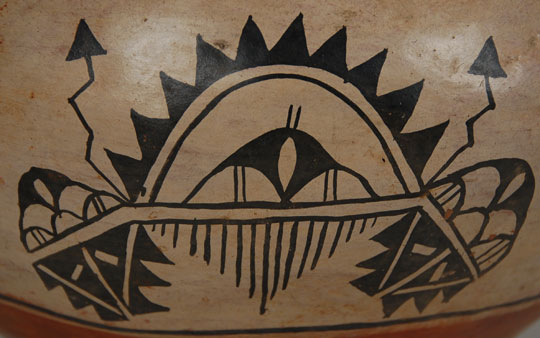Historic Cochiti Pueblo Black-on-cream Olla with Traditional Designs [R]
+ Add to my watchlist Forward to Friend
Forward to Friend
- Category: Historic
- Origin: Cochiti Pueblo, KO-TYIT
- Medium: clay, pigment
- Size: 9" tall x 11-1/2" diameter
- Item # C3335A
- Price No Longer Available
Stevenson and Cushing in 1879, and Stevenson, again, in 1880 made collections at Cochiti Pueblo and they noted that the majority of pieces being made there were figurative pieces and effigy vessels, with almost no ollas or bowls being made. This has been a long tradition at Cochiti. It is interesting that they were so involved in making figurative pottery for tourist consumption when they really were not near Route 66 or other tourist traveled locations. They must have traveled into Santa Fe to sell their pottery to traders in town because it is not likely that tourists traveled the road to the pueblo.
This superb olla is from Cochiti Pueblo and dates to circa 1900. It is not only typically Cochiti in all technical aspects: crystalline-rock temper in the paste, stone-polished, bare-paste underbody with red banding, black rim top with red neck interior, rag-wiped bentonite slip and black vegetal paints, but follows Cochiti tradition in design as well.
Cochiti is one of the few pueblos that permit decorative items to be used that are normally considered sacred and reserved for ceremonial vessels. It is interesting that this lack of restriction by Cochiti Pueblo exists when it is so close to Kewa Pueblo, which has strict rules prohibiting use of such symbols on anything that is considered to be a secular vessel. The symbols, of course, are lightning, clouds and rain, as seen on this olla.
Condition: The jar is structurally in excellent condition. UV examination does not reveal any repairs, restoration, or over-paint.
Provenance: ex coll Ray Kappmeyer, Danville, IN
ex coll Santa Fe, NM resident
Recommended Reading: A River Apart: The Pottery of Cochiti and Santo Domingo Pueblos

- Category: Historic
- Origin: Cochiti Pueblo, KO-TYIT
- Medium: clay, pigment
- Size: 9" tall x 11-1/2" diameter
- Item # C3335A
- Price No Longer Available



